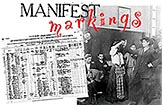

|
References to Other Pages or Lists |
|
Occasionally one will find annotations that refer to other passenger lists. The other list may be
another page of the same ship's list, or it may refer to a different ship arrival, on a different
date, or at another port. The cross-references link passengers who are related somehow but not
listed together, or links the various records of one passenger who arrived more than once.
Cross-references are usually, but not always, found in the Name column. |
|
References to other pages of the same ship's list . . .
The annotation at right indicates that two teenage steerage passengers are actually traveling with their mother. But their mother is a U.S. citizen, so she is listed on another page listing U.S. citizens. They are "with mother" on list of "USC"itizens, either page 27, line 25, or on lines 25 through 27. |
 |
| Movements between Steerage, First, and Second Class Cabin. Some immigrants changed their class of ticket either just before departure or once underway, much like airline passengers today might "upgrade" to first class just before the flight departs. If the change came at the last minute or once the ship sailed, it was too late to be recorded in the final draft of the passenger list. As a result, pursers annotated lists to show the change. The example at right, found in the name column, indicates the passenger "transferred to Third Class." The example below explains that the passenger's Steerage list record is lined out because he transferred to Second Class. |  |
 |
|
| Often, when a passenger moved between classes in this manner, the result is two records of the same person on the same ship--one record on the list as originally booked, and another on the list of the class in which the immigrant arrived. The same could happen when an immigrant for some reason "missed the boat" upon which he was booked and took the next ship instead. In those cases, he may appear to arrive twice, on ships arriving one after each other. If last minute changes could cause one immigrant to be listed twice, it is reasonable to assume the same situation might also cause an immigrant to fall through the cracks and not be listed at all. | |
| References to other ship lists |
|
Many immigrants arrived in the United States several times, and consequently have more than one
passenger list record. Sometimes these additional records are only suggested by Verification of
Landing annotations found in the Left Margin. But at other times, the linkage
between two records of the same person are unmistakable. One of the most striking differences between
an immigrant's original arrival and a later entry is the "Americanization" of their names between arrivals.
The examples below relate to three men listed together on the SS Pocahontas, which arrived in New York in mid-June, 1920. All three of the men were returning on that voyage, each having been previously admitted in earlier years. And all three have their records linked by references to earlier passenger lists. It appears all three had their records cross-referenced as a result of naturalization activity. |
|
Note that since these annotations were made years before microfilming of the records, they make no mention of National Archives or LDS microfilm roll numbers. Rather, they rely on the volume, page, and line numbers. The page numbers correspond to "stamped" page numbers on the passenger lists that run consecutively through a volume (as opposed to other numbers original to the ship list).